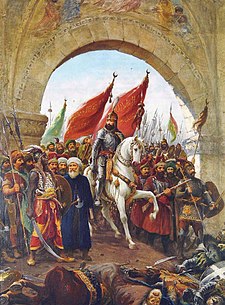Zagan Pasha
Mahmud Pasha Angelovic | |
|---|---|
| Personal details | |
| Born | c. 1426 |
| Died | 1469 (aged 42–43) Ottoman Army |
| Rank | Kapudan Pasha (grand admiral; 1463–1466) |
| Battles/wars | Fall of Constantinople Siege of Belgrade (1456) Expedition to the Morea (1458) |
Zaganos or Zagan Pasha (
Life
Origin and early life
Zaganos was conscripted through the
In a vakfiye (foundation) his name appears as "Zağanos bin Abdullah", which indicates that he was of devshirme origin.[6]
When Mehmed II was exiled in 1446, Zagan accompanied him.[4]
Second Vizier
Young Mehmed II had after his return and accession (18 February 1451) confirmed Çandarlı Halil Pasha the Younger as his first Vizier (even though he seems to have disliked him), and raised Zaganos Pasha from third to second Vizier.[4][5] Halil Pasha had been appointed first Vizier in 1439, after the demotion of Ishak Pasha.[7] Zaganos, who was younger, was jealous of the position of Halil Pasha.[8]
Conquest of Constantinople

During the
After the Ottoman occupation of Constantinople, the Sultan ordered Zaganos to set out with his galleys for Galata, to prevent the Byzantine ships from setting sail.[12][when?]
The stories of Halil Pasha's collaboration with the Byzantines were most likely spread by the faction of Zaganos.
Personality and appearance
Zaganos was said to be a tall and intelligent man.[citation needed] He has been called the most cruel Ottoman captain of his time,[13] and was said to be an enemy of Christians.[8] He was in absolute loyalty to Mehmed II, even when he was just a prince, knowing that his prospects depended on his master's success.[4] Zaganos was a soldier who believed that the Ottoman Empire must always expand in order to keep the enemies off-balance.[4] He was known for his warlike beliefs and played an important role in the 1453 Fall of Constantinople.
He was one of the prominent Ottoman
Military achievements
During the final siege of Constantinople, Zagan Pasha's troops were the first to reach the towers. Ulubatlı Hasan was the first soldier who reached the tower. During the siege many of the sappers were placed under the command of Zagan Pasha. Mehmed took Zaganos' advice almost exclusively.
Mehmed II honored him for his loyalty and honesty, along with the Sultan's two other Viziers, Halil Pasha and Sarica Pasha, by naming the three great towers of
Family
This section needs additional citations for verification. (July 2016) |
Wives
He had three wifes:
- Sitti Nefise Hatun. Daughter of Timurtaşoğlu Oruç Pasha, governor-general of Anatolia under Murad II. By her he had two sons and two daughters. She died or Zagan divorced by her before 1444.
- Fatma Hatun (1430 - 1464 or after). Daughter of Sultan Murad II and Hüma Hatun and full-sister of Sultan Mehmed II. They married in 1444 and divorced in 1462. By her he had two sons. [14]
- Anna Hatun (m. 1463). Daughter of Emperor David of Trebizond and Helena Kantakouzene, daughter of Demetrios I Kantakouzenos. Mehmed II ospited her in his harem after defeating her father and offered her in wife to him in exchange for permission to marry Zaganos' daughter, Hatice Hatun.[15][16]
Sons
He had at least four sons:
- Mehmed Bey - son of Sitti Nefise Hatun
- Ali Çelebi - son of Sitti Nefise Hatun
- Hamza Bey - son of Fatma Hatun
- Ahmed Çelebi - son of Fatma Hatun. He became an important adviser to his cousin, Sultan Bayezid II.
Daughters
He had at least two daughters:
- Selçuk Hatun - daughter of Sitti Nefise Hatun. She married Mahmud Pasha Angelovic and later became the lover of Şehzade Mustafa, son of Mehmed II. By her husband she had a son, Ali Bey, and a daughter, Hatice Hatun.
- Hatice Hatun - daughter of Sitti Nefise Hatun. She became a consort of Sultan Mehmed II. After Mehmed's death, she married a statesman.
Legacy
His, as well as his family's, mausoleum is located in his endowment (1454), Zagan Pasha Mosque, in Balıkesir.[4]
Portrayals
- İstanbul'un Fethi(1951).
- Zaganos Pasha is portrayed by Sedat Mert in Turkish film Fetih 1453 (2012).
- Ushan Çakır plays Zaganos Pasha in the Turkish TV Series Documentary Rise of Empires: Ottoman.
References
- ^ a b Stavrides, p. 63
- ^ Jones 1973, p. 7
- ^ Goldberg-Kasaba-Migdal 1993, p. 153
- ^ a b c d e f g h i j k l Nicolle 2007, p. 189
- ^ a b Philippides 2007, p. 95
- ISBN 978-975-389-785-3.
- ^ Philippides 2007, p. 171
- ^ a b Jones 1973, p. 32
- ^ Runciman 1965, pp. 94–95.
- ISBN 1-4013-0850-3
- ^ Runciman 1965, pp. 126–128, 169–170
- ^ Jones 1973, p. 53
- ^ Philippides 2007, pp. 177–179
- ^ Babinger 1992, p. 173.
- ISBN 0-521-45531-6.
- ^ Babinger 1992, p. 230.
Sources
- OCLC 716361786.
- J. R. Melville Jones, The Siege of Constantinople 1453: Seven Contemporary Accounts, Hakkert, 1973, p. 7: "Zagan Pasha"
- Ellis Goldberg, Reşat Kasaba, Joel S. Migdal, "Rules and rights in the Middle East" (1993), p. 153
- Kinross, Patrick Balfour (1977). The Ottoman centuries: the rise and fall of the Turkish Empire. Cape. ISBN 978-0-224-01379-6. Retrieved 5 October 2010.
Zaganos Pasha
- Nicolle, David; Haldon, John F.; Turnbull, Stephen R. (2007). The fall of Constantinople: the Ottoman conquest of Byzantium. Osprey Publishing. pp. 189–. ]
- Philippides, Marios (2007). Mehmed II the Conqueror and the fall of the Franco-Byzantine Levant to the Ottoman Turks: some western views and testimonies. ACMRS/Arizona Center for Medieval and Renaissance Studies. ISBN 978-0-86698-346-4. Retrieved 5 October 2010.
- Stavrides, Théoharis (2001). The Sultan of Vezirs: The Life and Times of the Ottoman Grand Vezir Mahmud Pasha Angelovic (1453–1474). Brill. ISBN 978-90-04-12106-5.

